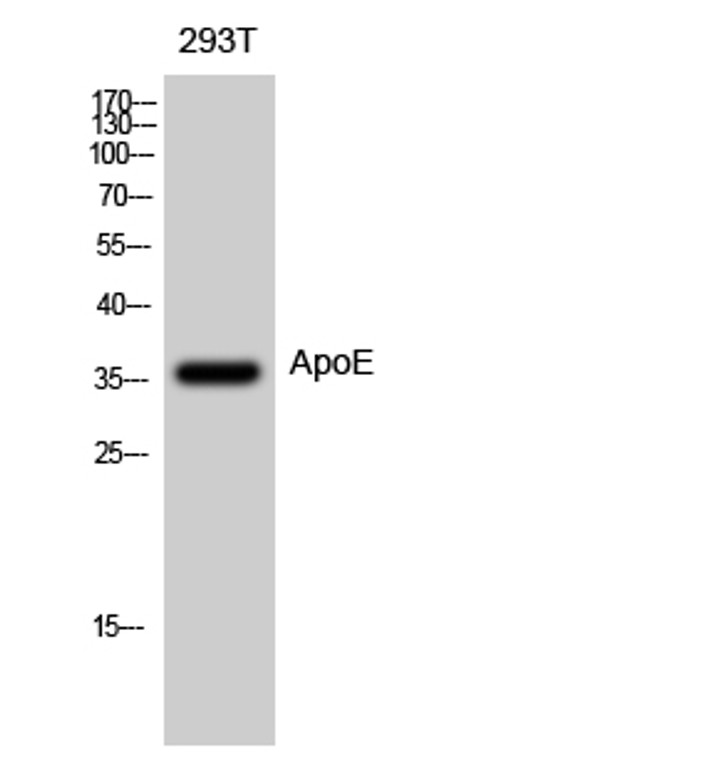| Host: |
Rabbit |
| Applications: |
WB/IHC/IF/ELISA |
| Reactivity: |
Human/Mouse/Rat |
| Note: |
STRICTLY FOR FURTHER SCIENTIFIC RESEARCH USE ONLY (RUO). MUST NOT TO BE USED IN DIAGNOSTIC OR THERAPEUTIC APPLICATIONS. |
| Short Description: |
Rabbit polyclonal antibody anti-Apolipoprotein E (37-86 aa) is suitable for use in Western Blot, Immunohistochemistry, Immunofluorescence and ELISA research applications. |
| Clonality: |
Polyclonal |
| Conjugation: |
Unconjugated |
| Isotype: |
IgG |
| Formulation: |
Liquid in PBS containing 50% Glycerol, 0.5% BSA and 0.02% Sodium Azide. |
| Purification: |
The antibody was affinity-purified from rabbit antiserum by affinity-chromatography using epitope-specific immunogen. |
| Concentration: |
1 mg/mL |
| Dilution Range: |
WB 1:500-1:2000IHC 1:100-1:300ELISA 1:10000IF 1:50-200 |
| Storage Instruction: |
Store at-20°C for up to 1 year from the date of receipt, and avoid repeat freeze-thaw cycles. |
| Gene Symbol: |
APOE |
| Gene ID: |
348 |
| Uniprot ID: |
APOE_HUMAN |
| Immunogen Region: |
37-86 aa |
| Specificity: |
ApoE Polyclonal Antibody detects endogenous levels of ApoE protein. |
| Immunogen: |
The antiserum was produced against synthesized peptide derived from the human ApoE at the amino acid range 37-86 |
| Post Translational Modifications | APOE exists as multiple glycosylated and sialylated glycoforms within cells and in plasma. The extent of glycosylation and sialylation are tissue and context specific. Plasma APOE undergoes desialylation and is less glycosylated and sialylated than the cellular form. Glycosylation is not required for proper expression and secretion. O-glycosylated with core 1 or possibly core 8 glycans. Thr-307 and Ser-314 are minor glycosylation sites compared to Ser-308. Glycated in plasma VLDL of normal subjects, and of hyperglycemic diabetic patients at a higher level (2-3 fold). Phosphorylated by FAM20C in the extracellular medium. Undergoes C-terminal proteolytic processing in neurons. C-terminally truncated APOE has a tendency to form neurotoxic intracellular neurofibrillary tangle-like inclusions in neurons. |
| Function | APOE is an apolipoprotein, a protein associating with lipid particles, that mainly functions in lipoprotein-mediated lipid transport between organs via the plasma and interstitial fluids. APOE is a core component of plasma lipoproteins and is involved in their production, conversion and clearance. Apolipoproteins are amphipathic molecules that interact both with lipids of the lipoprotein particle core and the aqueous environment of the plasma. As such, APOE associates with chylomicrons, chylomicron remnants, very low density lipoproteins (VLDL) and intermediate density lipoproteins (IDL) but shows a preferential binding to high-density lipoproteins (HDL). It also binds a wide range of cellular receptors including the LDL receptor/LDLR, the LDL receptor-related proteins LRP1, LRP2 and LRP8 and the very low-density lipoprotein receptor/VLDLR that mediate the cellular uptake of the APOE-containing lipoprotein particles. Finally, APOE has also a heparin-binding activity and binds heparan-sulfate proteoglycans on the surface of cells, a property that supports the capture and the receptor-mediated uptake of APOE-containing lipoproteins by cells. A main function of APOE is to mediate lipoprotein clearance through the uptake of chylomicrons, VLDLs, and HDLs by hepatocytes. APOE is also involved in the biosynthesis by the liver of VLDLs as well as their uptake by peripheral tissues ensuring the delivery of triglycerides and energy storage in muscle, heart and adipose tissues. By participating in the lipoprotein-mediated distribution of lipids among tissues, APOE plays a critical role in plasma and tissues lipid homeostasis. APOE is also involved in two steps of reverse cholesterol transport, the HDLs-mediated transport of cholesterol from peripheral tissues to the liver, and thereby plays an important role in cholesterol homeostasis. First, it is functionally associated with ABCA1 in the biogenesis of HDLs in tissues. Second, it is enriched in circulating HDLs and mediates their uptake by hepatocytes. APOE also plays an important role in lipid transport in the central nervous system, regulating neuron survival and sprouting. APOE is also involved in innate and adaptive immune responses, controlling for instance the survival of myeloid-derived suppressor cells. Binds to the immune cell receptor LILRB4. APOE may also play a role in transcription regulation through a receptor-dependent and cholesterol-independent mechanism, that activates MAP3K12 and a non-canonical MAPK signal transduction pathway that results in enhanced AP-1-mediated transcription of APP. (Microbial infection) Through its interaction with HCV envelope glycoprotein E2, participates in the attachment of HCV to HSPGs and other receptors (LDLr, VLDLr, and SR-B1) on the cell surface and to the assembly, maturation and infectivity of HCV viral particles. This interaction is probably promoted via the up-regulation of cellular autophagy by the virus. |
| Protein Name | Apolipoprotein EApo-E |
| Database Links | Reactome: R-HSA-1251985Reactome: R-HSA-3000480Reactome: R-HSA-381426Reactome: R-HSA-8864260Reactome: R-HSA-8957275Reactome: R-HSA-8963888Reactome: R-HSA-8963901Reactome: R-HSA-8964026Reactome: R-HSA-8964058Reactome: R-HSA-9029569Reactome: R-HSA-975634Reactome: R-HSA-977225 |
| Cellular Localisation | SecretedExtracellular SpaceExtracellular MatrixExtracellular VesicleEndosomeMultivesicular BodyIn The PlasmaApoe Is Associated With ChylomicronsChylomicrons RemnantsVldlLdl And Hdl LipoproteinsLipid Poor Oligomeric Apoe Is Associated With The Extracellular Matrix In A Calcium- And Heparan-Sulfate Proteoglycans-Dependent MannerLipidation Induces The Release From The Extracellular MatrixColocalizes With Cd63 And Pmel At Exosomes And In Intraluminal Vesicles Within Multivesicular Endosomes |
| Alternative Antibody Names | Anti-Apolipoprotein E antibodyAnti-Apo-E antibodyAnti-APOE antibody |
Information sourced from Uniprot.org
12 months for antibodies. 6 months for ELISA Kits. Please see website T&Cs for further guidance









